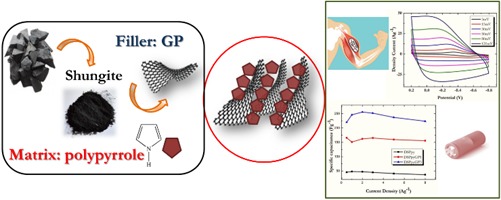Soft Materials

Conductive Polymers
Conducting polymers are a unique class of materials that combine the electrical properties of semiconductors with the processability of polymers.
The primary structure of conducting polymers is characterized by a conjugated backbone, typically comprising aromatic rings or alternating double and single bonds, that allows for the delocalization of π-electrons along the polymer backbone. This delocalization facilitates the movement of charge carriers, imparting electrical conductivity to the material.
Conducting polymers represent a versatile and rapidly advancing field, with ongoing research aimed at enhancing their properties and expanding their applications across various high-tech industries.
To this end, our group works extensively on developing synthesis methods to prepare polymer-based micro- and nanomaterials and nanocomposites with controlled morphology, molecular and crystalline structure, electrical and electrochemical functionalities.
For composites we also investigate the effect of platelet, nanotube, and particulate carbon nanofillers on the properties of the final material. We can arrange polymer systems and composites into discrete fibrillar globules, fibers, nanoparticles, and films depending on the polymer (PANI, PEDOT, PPY) and the synthesis approach adopted.
Also, we properly modulate the optical, thermal, and mechanical properties of the polymer materials for integration in applications ranging from organic electronics, sensors, energy storage, electrochromic and biomedical devices.

3D Hydrogels and Composite
Cellulose is a natural polysaccharide formed by long linear chains of glucose units (β-D-glucopyranose) linked by β(1→4) bonds. It is the main component of plant cell walls and is the most abundant organic polymer in nature. It’s biocompatible and biodegradable and endowed with high mechanical strength (especially when crystalline). Even if it’s insoluble in water, it can be chemically modified (e.g., to obtain derivatives such as CMC, HEC, MCC) and form porous and cross-linked structures. It can be used as support for hydrogels, films and membranes and in biomedical devices and as additive, excipient in Food and pharmaceutical industry.
Xanthan gum is an extracellular polysaccharide produced by bacteria of the genus Xanthomonas campestris. It consists of a branched structure with a skeleton similar to cellulose, but with side chains containing mannose and glucuronic acid. It’s highly hydrophilic and it easily forms viscous gels in water, even at low concentrations. Stable at different pH and temperatures, it’s compatible with other polymers. It’s widely used as thickener and stabilizer in foods, cosmetics, and drugs and as matrix for smart or stimulus-responsive hydrogels, and in bioink for bioprinting.
If this topic is of interest to you, we invite you to visit our vacancies page or drop by one of our offices to discuss it in person!



